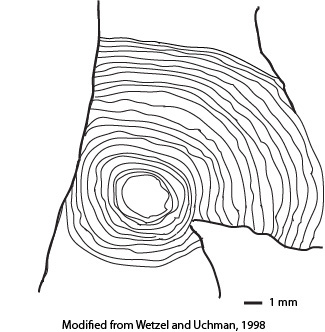Rotundusichnium Plicka 1989
DESCRIPTION: Spirally coiled, partially overlapping ribbons inclined toward the center of spiral. The ribbons may be perpendicularly striated, up to 20 cm in diameter.
BEHAVIOR(S): Feeding traces
ENVIRONMENTAL SETTINGS: Marine flysch deposits
POSSIBLE TRACEMAKERS: Marine worms
GEOLOGIC RANGE: Paleocene-Eocene
ADDITIONAL REFERENCES: Uchman 1998, Wetzel and Uchman, 1998
REMARKS: Rotundusichnium was erected by Plicka (1989) to distinguish Spirorhaphe zumayensis (Gomez de Llarena). Plicka stated that this trace fossil differs of Spirorhaphe typified by S. involuta De Stefani. Seilacher (1977b, 1978) included this trace fossil in Scolicia, however, features of Scolicia are usually not visible. The problem of ichnogeneric affinity for Rotundusichnium still exists. Rotundusichnium has been found in shallow tiers in Paleogene flysch deposits of Poland. They were produced near the surface and are currently interpreted as feeding traces. Their producers efficiently exploited the sediment and, hence, a relatively high benthic food content is inferred. The producers of these trace fossils did not maintain an open connection to the water column. The relatively thick upper tier, therefore, indicates that the sediments were highly oxygenated at depth. Bioturbation by shallowly burrowing organisms enhances the movement of oxygen into the sediment (Reimers et al., 1986) and extends the oxygenated zone downward (Wetzel and Uchman, 1998).
